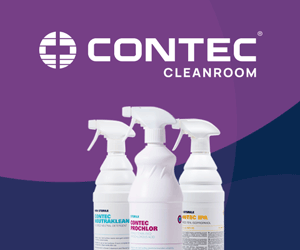It is not only healthcare facility structures that need to be designed with hygiene and easy cleaning in mind. To stop the spread of HCAIs, everyday furnishings and equipment also need to be easy to clean – which is why the UK’s Design Council recently ran a “Design bugs out” programme. Cleanroom Technology reviews the results.
The World Health Organisation has estimated that at any given time, 1.4 million people worldwide suffer from healthcare acquired infections (HCAIs). Over-use of antibiotics and poor hygiene practices in recent years have allowed relatively benign bugs to become superbugs that pose a real danger to those already weakened and immuno-challenged due to illness or undergoing surgical procedures. For this reason, national governments and health authorities are doing what they can to improve hygiene practices and to introduce new technologies that can help combat the spread of HCAIs, especially MRSA and C. difficile. The UK Department of Health and the NHS, for example, set up a programme called Smart Solutions, which invited businesses from all industry sectors to put forward suitable products and technologies to be assessed by a team of experts, with a view to evaluating them in a hospital setting and potentially supplying them across the whole of the NHS.
As part of this Innovation programme, the UK Design Council was commissioned to lead a “Design bugs out” project. Teams of designers and manufacturers, were asked to set out how they would tackle the design challenges that were identified following extensive research in hospitals across the UK involving nurses, patients, cleaners, porters and other healthcare staff. First, a panel of the UK’s most respected experts in the fields of design, healthcare, microbiology, nursing and patient care was assembled to assess which items in the hospital environment, if redesigned, could have the most potential to reduce patient’s exposure to HCAIs through contact with their immediate surroundings.
During development of the designs, the winning teams had access to advice from the expert panel, which included distinguished designers, Tom Dixon OBE and Richard Seymour; Professor Brian Duerden CBE, Inspector of Microbiology & Infection Control at the Department of Health; Professor Peter Borriello, one of the UK’s leading microbiologists; and Susan Osborne CBE, Chief Nurse for the Eastern Strategic Health Authority.
As a result of the programme, several prototypes of hospital furniture and equipment, aimed at helping the fight against MRSA and other HCAIs, are now being promoted by the UK Design Council.
The prototypes use cutting edge techniques to rethink the bedside environment, patient transport and everyday medical equipment, making them much easier to clean. They were also designed to influence patient and staff behaviour to reduce the likelihood of patient exposure to HCAIs.
The prototypes include: • A “21st century commode” or portable toilet that is easy to take apart for cleaning, and practically eliminates the hard-to-clean gaps and joins that characterise current designs.
• A redesigned porter’s chair that is durable, comfortable, and cleverly uses design to make it easy to clean while reducing the number of obvious user “touchpoints” where infection can be spread.
• An “intelligent” mattress that changes colour when it becomes compromised by body fluids, indicating that a change of mattress or cleaning operation is necessary.
• A patient bedside system comprising bedside storage and over-bed table that eliminates hard-to-clean corners, is made of special durable, scratch-resistant materials, and is easier for patients to use unaided.
• A new patient chair that pioneers a system of magnetised, removable cushions with easy-change laundered covers that make the chair clean, safe and comfortable.
• A self-timing cannula (tube for delivering fluids to the patient) with an indicator telling staff when the intravenous line needs to be changed.
• A curtain clip – handles for cubicle curtains that, through a unique design and magnetic mechanism, provide an easily sanitised “grab-zone” and also keep the curtains securely closed.
• A wipeable, polyethylene-covered blood-pressure cuff with magnetic closures, instead of hard-to-clean Velcro fastenings.
Top designers and manufacturers, renowned for design icons ranging from Virgin Atlantic’s Upper Class airline seats to Herman Miller chairs and Parker pens, were asked to help work on the furniture and porter’s chair. A specialist healthcare team from the Helen Hamlyn Centre, Royal College of Art, developed the designs for everyday equipment, such as the self-timing cannula, blood pressure cuff and “intelligent” mattress.
Reviewing the success of the scheme, David Kester, chief executive of the Design Council, said: “The programme has provided a great model for procurement that genuinely taps the inventiveness and ingenuity in the UK. The results are good for the nation’s health and good for the economy, as many of these designer-manufacturer teams will be able to sell their new concepts to markets all over the world.”
He added: “MRSA and C. difficile dominate headlines and raise concerns for us all. “Design bugs out” has demonstrated that a little bit of good design can go a long way to providing simple, practical solutions based on the real needs of patients and hospital staff. While the designers and manufacturers deserve the big plaudits, the NHS also deserves a pat on the back for recognising design as a “midwife” for innovation.”
Richard Seymour, chair of the judges and one of the UK’s most respected and influential designers, said: “This is the probably the most important thing these designers will do this year – or perhaps in their entire career. It’s a unique opportunity genuinely to affect lives and to leave a lasting legacy, which will continue to help protect people’s health for years to come.”
The working prototypes are now being taken on a UK tour of seven “showcase hospitals” which are trialling and evaluating other new technologies as part of the HCAI Technology Innovation Programme.
Contact www.designbugsout.org.uk www.smartsolutionsforhcai.co.uk




